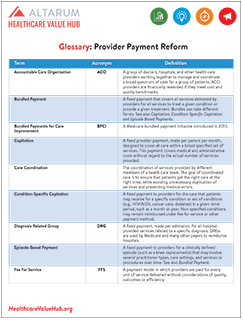Improving Value
Pay for Performance (P4P)
Pay-for-Performance (P4P) is an alternative payment model in which participating providers can receive bonus payments for meeting quality/efficiency targets. Providers that do not perform well may be financially penalized, “thus providing a significant linkage between payment and quality.”1 Incentives can range from small bonuses for a few quality indicators to large bonuses (constituting approximately one-quarter of providers’ incomes) for performance on over 100 metrics.
Prominent P4P programs include:
- The Hospital Value-based Purchasing Program, which offers acute care hospitals incentive payments for providing high quality care to Medicare beneficiaries;
- The Hospital Readmissions Reduction Program, which lowers payments to participating hospitals with too many readmissions; and
- The Merit-based Incentive Payment System, which ties physician (and select other clinician) payment to the quality/cost of care provided to Medicare beneficiaries, use of electronic health record technology and the completion of practice improvement activities.2
A 2014 RAND report concluded that:
"Although the past decade has witnessed a fair amount of experimentation with performance-based payment models, primarily P4P programs, we still know very little about how best to design and implement value-based payment programs to achieve stated goals and what constitutes a successful program."3
More recent evaluations continue to demonstrate lackluster results. A 2017 systematic review observed that, although many studies documented positive effects associated with P4P programs, the results were inconsistent across studies, the magnitude of effect was often small and it was difficult to confidently credit observed changes in outcomes to the intervention because of the studies’ observational nature and methodological flaws.4 Furthermore, many of the studies reporting positive findings were conducted in the United Kingdom, where incentives were much larger than any P4P programs in the United States.
Problems with P4P programs include the fact that most physicians believe that the quality measures used are inaccurate. Risk adjustment methodologies are still rudimentary and do not account for socioeconomic factors, leaving physicians and hospitals caring for high-risk populations (such as those in poor urban areas) at risk for lower quality scores. Moreover, performance scores in the Merit-based Incentive Payment System are relative, meaning that they are not determined by how well providers satisfy the metrics, but their performance in comparison to their peers. Many providers think it is unfair to be punished for performing well, but less well than their peers, creating a strong incentive for them to seek exemption from the program.
Questions also remain about which models payers should adopt if they want the best savings/improvements in care and which models are scalable so a broader swath of the population can reap the desired benefits.
Notes
1. Healthcare Payment Learning & Action Network, Alternative Payment Model Framework (2017).
2. Ballou, Jeffrey, Repeal and Replace, Part II: Improving Pay-for-Performance in Medicare, Mathematica Policy Research (Dec. 1, 2018).
3. Damberg, Cheryl L., et al., Measureing Success in Health Care Value-Based Purchasing Program: Summary and Recommendations, RAND Corporation (2014).
4. Mendelson, Aaron, et al., The Effects of Pay-for-Performance Programs on Health, Health Care Use, and Processes of Care: A Systematic Review, Annals of Internal Medicine, Vol. 166, No. 5 (Jan.10, 2017).







